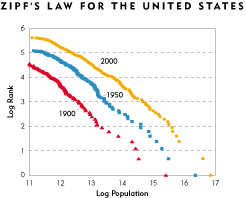To the causal observer, cities often give the impression of disordered muddles—the result of random decisions and historical accidents. Time and again, attempts to plan them are blocked by natural barriers, unforeseeable budget cuts and human caprice. But this notion of chaos is belied by the research of economists, geographers and mathematicians who have discovered striking regularities in metropolitan growth.
Urban sprawl, for example, may appear a messy outcome of uncontrolled impulses, but students of cities say sprawl often exhibits geometric patterns that mathematicians call "fractals"—repeated shapes easily expressed in algebraic formulas.
Two other powerful empirical patterns relate to the "density gradient"—the rate at which population density falls with distance from the city center. In almost every city in the developed world, the density gradient is positive—that is, its population density declines as one moves farther from the center.
But overall trends in gradients are negative—in other words, cities are "decentralizing." London, for example, had a density gradient of 1.26 in 1801 but it had fallen to 0.14 by 1961—still positive but drastically reduced. New York's gradient fell from 0.32 in 1900 to 0.18 in 1950.
Zipf's law of cities
Another striking pattern—"one of the most overwhelming empirical regularities in economics!" according to Princeton economist Paul Krugman—is that described by Zipf's law, or its sister, the rank-size rule.
In a nutshell, the rank-size rule says that if you take all the cities in a country and rank them top-to-bottom by population, the second largest city will have half the population of the largest, city No. 3 will have a third the population of No. 1, and so on. (Zipf's law states the same relationship in terms of probability: The likelihood that a city has a size greater than S is proportional to 1/S.) There's no obvious reason for this relationship among cities, but the pattern holds with remarkable strength.
Graphs of this relationship are also remarkable. If the vertical axis of a graph shows a city's rank (largest city has rank 1; second largest, rank 2; etc.) and the horizontal axis shows the city's population, plotting the entire set of a country's cities will describe a uniform curve sloping downward from left to right. If you take the natural logarithms of both rank and population, the graph will be a straight line that slopes down at a 45-degree angle.
Zipf's law—named after Harvard linguist George Zipf but actually discovered earlier by German physicist Felix Auerbach and described even earlier by the Italian economist Vilfredo Pareto in relationship to company revenues—works (approximately) for cities in the United States (see graph) and many other nations.

The relationship holds strongly for the midsection of most city data sets but weakens at the ends-that is, for the biggest and smallest cities. New York's population isn't actually twice that of Los Angeles, for example, but the populations of Denver (No. 20 in 1997) and Tampa (No. 21) fit the Zipf line almost perfectly.
Source: In "Urban Structure and Growth" by Esteban Rossi-Hansberg
and Mark Wright, Stanford University, Working Paper, May 21, 2004.
Achieving balance
Urban scholars aren't sure why this pattern exists, but one of the more interesting theories is expressed in a recent working paper—originally a Minneapolis Fed discussion paper—by Stanford economists Esteban Rossi-Hansberg and Mark Wright. In "Urban Structure and Growth," they suggest that the pattern results from the interplay of underlying economic forces.
As they grow, cities balance forces of attraction against those of dispersion. Knowledge spillovers and concentrated markets, for instance, provide incentives for economic activity to take place in cities, but congestion and high land prices push businesses away from the central core. "In our framework," write the economists, "cities result out of the trade-off between commuting costs and local production externalities in human capital and labor."
The full economic explanation is highly technical—of course—involving factor accumulation, productivity shocks and yet another law, Gibrat's, which says the average and variance of a city's growth rate is independent of its size. But at the heart of their theory lies the need to reconcile the constant returns to scale usually seen in national economies with the increasing returns that create cities at the local level.
According to Rossi-Hansberg and Wright, national economies vary the number and size of cities in the regular pattern described by Zipf so that they can take advantage of economies of scale yet still grow along a balanced path. "It is the size distribution of cities itself," they write, "and its evolution through the birth, growth and death of cities, that leads to a reconciliation between increasing returns at the local level and constant returns at the aggregate level." Put otherwise, a national economy, like a living organism, shapes its internal structure so that the nation as a whole can expand on a stable course.
This, perhaps, is the invisible hand of urban growth.





